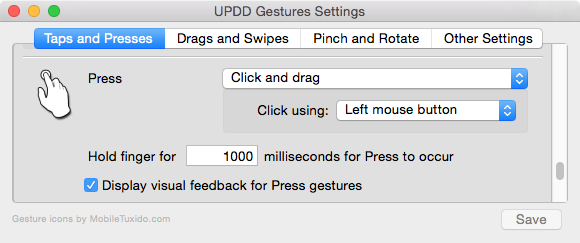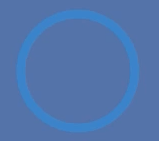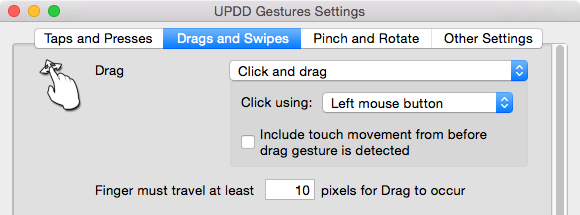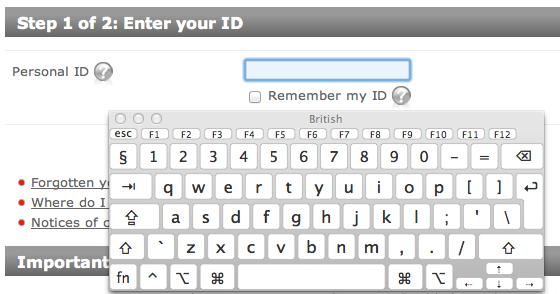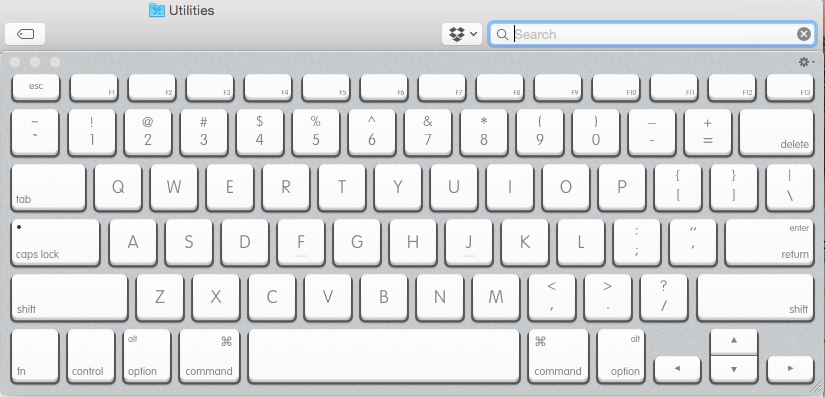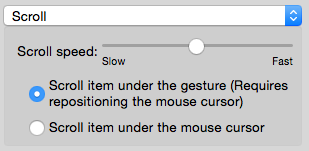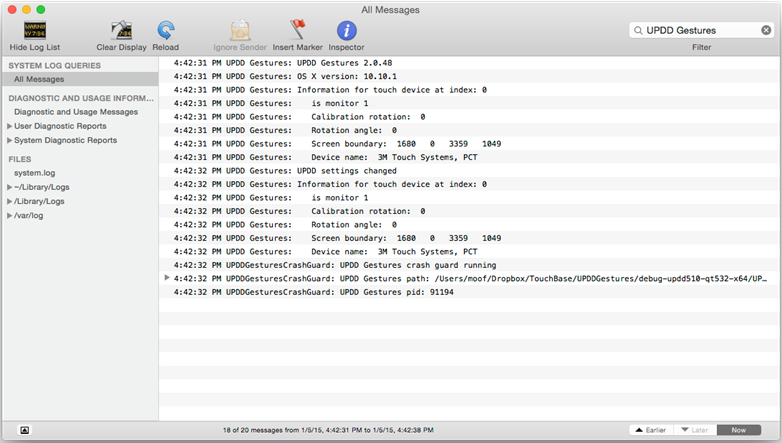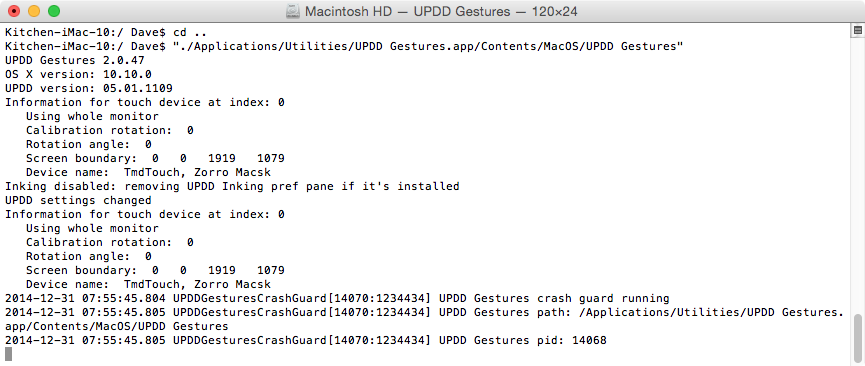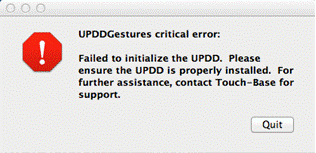|
|
UPDD – Gesture and Inking |
|||||||||||||||||||||||||||||||||||||||||||||||||||||||||||||||||||||||||||||||||||||||||||||||||||
|
Revision 1.52 – 11th Oct 2015 |
www.touch-base.com\documentation\General |
|||||||||||||||||||||||||||||||||||||||||||||||||||||||||||||||||||||||||||||||||||||||||||||||||||
|
|
||||||||||||||||||||||||||||||||||||||||||||||||||||||||||||||||||||||||||||||||||||||||||||||||||||
OverviewWith the advent of dual and multi touch pointer devices users can now use gestures to interact with the operating system and applications. The major desktop operating systems are all catering for gesture interaction and promoting the use of gestures within applications with well-defined gesture application interfaces.
UPDD can be configured to support single, dual and multi-touch devices. For each stylus in use the positional data is made available on the UPDD API as well as optionally passed into the OS and/or applications to cater for gesture utilization.
The injection of single, dual and multi-touch data into operating systems and their applications is dictated by the interface methods implemented within the OS environment. These are the interface methods utilised by the UPDD driver:
The interpretation of the gesture is dependent on the OS and application. There are many articles on the web to describe gesture utilisation by the OS desktop (windows manager) and key standard applications. However, a very useful gesture reference guide can be found here. ImplementationIt is our intention to build full gesture support into the driver and/or supporting utilities but in some cases we currently utilise external UPDD API based apps to handle gesture functionality. The current implementation of gesture support for various operating system is as follows:
Windows desktopUnder Windows Vista, 7 8 and 10 the driver has a user setting in the UPDD Console, called Extended touch. If enabled all touches are fed to the OS via the virtual HID device to invoke the extended touch functionality (gestures etc) built into these operating systems. If disabled all single touches and the touch data from the 1st stylus (of a multi touch device) are passed to the OS via the mouse port interface (mouse emulation).
Windows CEUPDD CE 4.1.10 handles touch via the CE standard GWES interface so CE gesture support can be utilised by any touch device using UPDD CE driver
Mac OS XFor this OS we use a standalone application which supports gestures and inking in Snow Leopard 10.6, Lion 10.7, Mountain Lion 10.8, Mavericks 10.9, Yosemite 10.10 and 10:11 El Capitan. Development history can be viewed from the menu bar item and can also be viewed here.
This section covers the following Mac OS X gesture topics:
Installation and running the gesture softwareTo utilise gestures and inking in the Mac environment you need to simply download the gesture .zip file below that matches your release of the and expand the compressed file to create the application file ‘UPDD Gestures’:
The latest gesture software is available here. Development history can be viewed here. This works with driver version 5.1.1430 and above (as seen in the UPDD Console, About Dialog) If you are running driver version 5.1.1264 or above the last compatible version of gestures is here (this will not work with driver version 5.1.1430 and above!) If you are running the very old 5.0.2 driver the last compatible version of gestures is here (this will not work with driver version 5.1.x!) It is highly recommended that the gesture application file is moved to the standard Mac OS X Utilities folder along with the other UPDD Mac applications. The driver uninstaller will only uninstall gestures if it is held at this location. Utilities folder
Simply
click on the application to run gestures. When running, a gesture menu
bar item,
if enabled, will be shown in the menu bar If this is enabled but does not appear see the troubleshooting section below. If the menu bar item is disabled but the gesture software is loaded then running the gesture software again will invoke the gesture settings dialog.
Important installation notes: 1. Retain original
name 2.
Requires
production version of the driver 3. Automatically
installed with driver 4. Invoking gesture
software at startup ·
Enable
via the Gesture GUI · Manually set up a
start up item Gesture uninstallThere are 2 simple steps to manually uninstall the gesture software: 1. Remove the start up item if gestures have been configured to be invoked at start up: · Invoke the Gesture GUI via the Gesture Menu item, Settings entry. · Select the Other Settings dialog · Uncheck the ‘Start UPDD Gestures at login’ option 2. Delete the application · Locate and drag the application to the trash can. System InterfacesAs the name suggests, Gestures is calculating the gesture performed on the touch screen and invoking actions associated with the gesture. However, in addition to this, the touch data is also posted into the OS as native multi-touch gesture events and positional touch events (see important note below) and since gesture version 2.1.x is also passed to the driver to make gesture information available on the driver’s API interface.In some specialist cases not all these 3 functions are required and we have introduced a number of settings to custom these interfaces as follows.TEAPIonly – no gesture actions are performed, touch data is posted as touch events and gesture information is posted on the APIAPIonly - gesture information is posted on the API only. This setting utilises a different gesture dialog.Because these settings are rarely used they are not set in the gesture GUI but via the Menu Bar item (since version 2.2.0),They can also be set via the UPDD Command Line interface. E.g tbutils nodevice setting dw APIonly 0 or set as default when supplying custom builds of the gesture software.This document is aimed at users using the main gesture feature.Important note: Under Mac OS X 10.10.2 and above we discovered that applications were no longer receiving the OS X positional touch events created by UPDD Gestures, only the gesture events. Our investigations revealed that these touch events simply weren't being passed along to applications unless they came from a genuine Apple trackpad. When force click events were introduced in 10.10.2 we also discovered that our attempts to send force click events (from touch screens that support pressure) were also blocked. We suspect that the 10.10.2 update blocks both force click and now also positional events unless they come from a trackpad and ignores any generated from a different source.As it stands, we can't think of a single piece of OS X software that uses the position of individual touches and therefore we are not sure if this restriction will caused any real issues. Further, OS X's positional touch events were always meant to represent a ‘touch’ from a trackpad, not a touch screen. Many applications rely on OS X gesture events and these are still processed and working.It is our intention to continue to investigate what is blocking positional and force click touch events and hopefully find a solution if one exists.Menu Bar itemOnce invoked, and if enabled, a Menu Bar icon indicates that the gesture application is loaded and running and can be used to quit the gesture touch function. Since version 2.0.14 the Menu Bar item can be optionally disabled and with some OEM versions of the gesture software this is the default state so no Menu Bar item is shown. The Menu Bar item can be enabled / disabled as required in the gesture settings dialog.
Notes: Gesture profiles: Profile files (.gpf files) can be placed in the UPDD folder but they can also put it in the equivalent folder in the user-level library directory, i.e.: ~/Library/Application Support/UPDD. This is because it's standard in OS X for it to be allowable to use both folders, especially since the user-level folder doesn't require administrator access to modify. Gesture OverviewThe gesture software disables the driver’s own posting of single touch data into the system and receives all touch from the touch device via the driver’s API interface. If gestures software is quit then touch will revert back to single touch via the driver’s own system interface. Should gestures crash a background process named UPDDGesturesCrashGuard will automatically restart the program and ensures that mouse emulation is re-enabled after Gestures terminates so that touches won't become unresponsive. The Gesture software posts all received touches as OS X's native touch events and as TUIO touches if configured (and UPDD TUIO server is running), regardless of whether there is a gesture being performed, as the gestures are more or less separate from the touches themselves. If gesture processing is not required (you do not require Gestures triggering any actions for the performed gestures on the touch screen), you can set the gestures to "No action", and applications will still be able to receive the individual touches. There is also a setting to request that touch data is posted into the system as tablet events, allowing a touch device to be used with Inking and other tablet-related features. It only affects mouse events produced by Gestures, though, since in OS X a tablet event is also a mouse event. Tablet/Pen device inputs supported by the driver/gestures are always passed into the system as tablet events. Pen nib and co-ordinate information bypasses the gesture engine, i.e. is not processed for gesture consideration. Application schematicAs described in the overview above, the gesture software interacts with the core UPDD driver or TUIO Server to receive all touches, calculates the gesture being performed, initiates the associated action and then injects the touches into the OS as native touch events and also optionally pass mouse actions as tablet events. The schematic for the gesture interface is as follows: Utilising the gestures and inking functions are described below. Gesture specificsGestures are performed on the touch screen exactly as they are on a track-pad. The action associated with each gesture can be defined in the gesture settings dialog. To utilize all available gestures you will need to use a multi-touch touch screen that supports up to 5 touches otherwise you will be restricted to the gestures that relate to the number of stylus supported on the touch screen. A number of videos have been posted on the web from end uses such as this one here. A guide to Lion gestures in PDF / Printable format is available here. Mountain Lion gestures are described here. Gesture videos can be seen here.
Saving and importing gesture configurationsGesture settings can be saved to and loaded from a file. This allows for gesture configuration sets to be loaded as required for specific desktop / application use or to save/share configurations.
Gesture logTo view the gestures being calculated by the gesture engine in real-time invoke the Show Gestures Log option in the menu bar:
For each “Detected gesture” there should be a corresponding “Effective gesture” indicating the gesture performed.
The example log above is from version 2.0.23 with additional logging information implemented to track down any reported occurrences where some "detected" gestures don't have an "effective" gesture. E.g. In the case of three finger drags and swipes, it should choose an "effective" gesture for one or the other every single time but we have had reported incidences of no effective gesture being selected. Should you experience this please send log output along with your support email.
A more detailed explanation follows of the log entries:
Detected gesture: *** ---> means the analysis detected a basic gesture, like three finger drag.
...Detected: *** ---> reveals new information from the analysis about the current gesture, e.g. the three finger drag is swiping left
Effective gesture: *** Performing action: *** ---> is which of the configurable gestures in the GUI is matched to the gesture from the analysis, and which action is being performed, e.g. it picks "three finger swipe left" instead of "three finger drag" and performs the appropriate action
Inoperative gesture: *** ---> is which of the configurable gestures could have been matched to the analysis but wasn't because of the user's settings, e.g. "three finger drag" because the effective gesture was "three finger swipe left"
(gesture ended) ---> means the analysis detected the end of a gesture
Gesture considerations The Two finger Tap invokes a right click which is generated by default under the left stylus. This behaviour can be changed to generate the right click under the right most stylus. A time threshold is also configurable to specify the time in which a two finger tap can occur. The Press and Tap invokes a right click which is generated by default under the first stylus. This behaviour can be changed to generate the right click under the second stylus. In OS X Snow Leopard, four finger swipes typically invoke one of the "Expose" features, or invoke the application switcher. Unfortunately there's no supported way to programmatically activate these features, so UPDDGesturesmacosx posts keystrokes that trigger them. Since the hot key for the "Expose" feature can be configured, UPDDGesturesmacosx reads in the Apple hot key preferences to determine which keystroke is the correct one to press. We believe this works quite successfully and in our test these features get activated consistently. We are keen to find out if it works consistently for our users – any feedback much appreciated! Given that touch screens are absolute pointer devices operating directly top of the video then, by default, gestures scrolls the contents of a window the same direction as your finger movement. However, trackpads have a scroll direction option under System Preferences to scroll window content with or opposite to the finger movement (Natural option checked or unchecked). E.g. scrolling to the left to view the contents under the left side of a window, meaning that that data has to scroll right to reveal the left side contents. Since gesture version 2.0.60 there is now a setting for scroll direction to "scroll", "swipe between full screen apps", and "pan screen" actions. Double click: Setting the tap gesture action to click then tapping twice will produce a double click (and triple clicks and so on) as expected and this is the most obvious method of producing double clicks. However, there is also a ‘double tab’ gesture and ‘double click’ action…… The purpose of the double tap gesture allows double tapping to produce a different action than a single tap, however this causes single taps to be delayed because Gestures needs to determine which of the two gestures is being performed before any action is triggered. The double click action can be associated with a gesture such that gesture will always perform a double click (e.g. having a three finger tap trigger a double click). It is not necessary to set the double tap gesture to the double click action be able to generated double clicks and in fact will introduce a delay in single clicks. Be warned! Press GesturePrior to version 2.0.59, Gestures was posting a "mouse dragged" event immediately after a "mouse down" event when performing the "click and drag" action but in Apple's gesture API, a press gesture is triggered by a mouse down event and no mouse drag events within a small span of time, so a press gesture (down no drag) was not possible. This has been addressed in 2.0.59 but it can still be difficult to generate a press gesture if there is the slightest movement after touch as this will cause there to be a (legitimate) "mouse dragged" event. Where this occurs you may be able to prevent slight movement by increasing the "stabilization" setting in driver’s UPDD Console.
In version 2.0.42 we added visual feedback to the press gesture to indicate the press operation is being performed and the point at which the click is activated. If this is enabled the countdown to the click is represented by the drawing of a blue circle and the click is performed at the point the circle is drawn complete. The circle drawing speed is dictated by the click time period, which is defaulted to 1000ms.
Drag GestureThe drag gesture is initiated once a single touch has passed the pixel threshold as defined below. This can introduce a small delay before a drag occurs. Prior to gesture version 2.2.0 any touch co-ordinates received within the pixel threshold are discarded, which can has an adverse effect on drawing quality when used in a drawing application as you will see a straight line between the initial point of touch and the outer limit of the pixel threshold. Lower the pixel threshold for smoother drawings. However, too low may have an adverse effect on gesture detection.
However, starting with gesture version 2.2.0 there is a new setting ‘Include touch movement from before drag gesture is detected’ If there is stylus movement during this wait period the touch data was previously discarded and touch only started at the point it was determined this is a single touch drag. With this setting enabled, incoming touch data is retained during this 'decision' period and posted to the OS once drag commences. This is useful in drawing package so that the drawing reflects the actual stylus movement. With this setting disabled the drawing can be slightly distorted at the beginning of each line.
Force Click / TouchIn early 2015 Apple introduced Force Touch functionality on trackpads on certain MacBooks. This allows pressure or force clicks on trackpads to interact with ‘force touch’ aware applications.
Some touch screens support ‘pressure’ and starting with gesture version 2.1.3 pressure related functionality has been added.
The aim of supporting pressure in gestures was twofold,
1) Utilise this
functionality within gestures 2) Post the pressure data into
the Mac system so as to interface with ‘force touch’ aware applications via
touch in the same way you can with a force track pad.
Currently missing from our “force click” feature as well as the "force press" and "force drag" gestures is auditory feedback. At some point soon we intend to add the option for there being a clicking noise when a force gesture or force click is triggered.
Force Touch functions are only available to pressure capable touch screens supported by the UPDD driver. Squeeze and Splay sensitivitySome users reported difficulty in activating actions associated with 4 and 5 finger squeeze and splay gestures. The gesture log would show that the gesture had been recognised but that the gesture hadn’t proceeded far enough along to be considered a full squeeze or splay hence the action was not invoked. To overcome this issue we have introduced in version 2.0.46 a sensitivity control that can be used to fine tune the decision process!
Squeeze and splay sensitivity determines how much your fingers must contract or expand during a squeeze/splay gesture to have it be detected as either a squeeze gesture or a splay gesture respectively. This comes into play after Gestures has detected that the current gesture is going to be a squeeze or splay gesture (as opposed to a different gesture like a four finger drag), but before there's been adequate movement to determine which of a squeeze or a splay it is. Due to it involving several fingers moving in different directions, squeeze/splay gestures are a little bit more difficult to detect than the other gestures, hence requiring more movement.
Single Touch gesturesMac OS gestures utilise 2 or more touches. However, in some circumstances, user may wish to map single touches to simulate flicks and swipes, especially when using single touch touch screens. With the latest gesture software each gesture can now be configured on a gesture-by-gesture basis. A typical gesture configuration for single touch touch screens would be as follows: Set Tap -> Click* Set Press -> Click and drag* Set Drag -> Scroll * note for these gestures that action is the default. Check the "Disable multitouch gestures" option in the "Other Settings" section. Finally, when configuring Gestures to be used with single touch we recommend the gesture setting "milliseconds for Press to occur" should be between 500-1000 milliseconds as you may experience an immediate click event on finger press when trying to perform a drag gesture.
Observed gesture action delayThese issues were initially raised by users using Avid Pro Tools and Proppelerhead Reason when using small audio faders or adjusting some controls to adjust their values. Tap Gestures cannot be certain a single touch is actually a tap until the finger has been released. You may observe a slight delay when tapping on buttons that's not present when Gestures isn't running or when using a mouse. This delay threshold can be adjusted in the Gesture Setting dialog under Taps and Presses. Drag By default, a single touch needs to move a minimum of 10 screen pixels in order for Gestures to detect it as a "drag" gesture so applications won't receive a mouse event until the 10 pixels have been traversed, creating the slight lag. With version 2.0.22 the pixel threshold is now configurable in the settings program, Drags and Swipes dialog and a smaller value reduces the lag or can eliminate it altogether. Note: As of version 2.0.31 we have added a setting for gesture detection sensitivity to adjust how accurate or responsive of the gesture detection process.
Understanding Swipes and dragsAs far as the gesture analysis function is concerned a swipe is fundamentally a drag gesture that's moving in one of the cardinal directions, which is to say swipes are a subset of drag gestures. The speed of the fingers or the time for which they contact the touch screen isn't considered, so a quick temp swipe on the screen and a slower, well defined movement should both be detected as a drag, and depending on the direction of movement also a swipe. It is for the reason the Gestures GUI has a setting for choosing between the two. What's going on behind the scenes in Gestures is that when the analysis determines that the touches are performing some manner of drag gesture, it also reports the swipe direction, if one is detected. This way an app using the analysis can decide which specific gesture it wants to respond to. We designed the analysis to be more general purpose, reporting all of the relevant information about a current gesture. There's separate logic in gestures to take the results of the analysis and decide which of the specific gestures in the GUI to respond to (like swipes vs. drags) based on the current gesture settings. Note: As of version 2.0.32 we both fixed a bug where scrolling using slow moving gestures would produce jerky, undesirable motion and generally improved feel and smoothness of scrolling and scrolling momentum so that it is now more similar to using an Apple trackpad. Clickable UI element feature
Notes when using this feature:
Pan and ZoomingStarting with version 2.0.44 we have added actions to pan and zoom. This has been tested in 10.6 thro’ 10.10 and appears to work well.
To allow these actions to be included as default actions without replacing existing ones we have split the squeeze and splay gestures into two separate gestures depending on whether four or five fingers are used and set it up so that four finger squeeze and splay zooms the screen in and out and four finger drags pans the screen around. However, we do think it works best though when using pinch and spread gestures for zooming and one-finger drags for panning so we recommend configuring it that way for best results. Since version 2.0.47 you can now hold the control key and use pinch/expand and two finger drag gestures to zoom and pan the screen respectively Correct zoom operation requires the OS X Zooming feature to be configured correctly in the Zoom section of the Accessibility system preferences (in OS X 10.8+) or the Universal Access system preferences (in OS X 10.6 and 10.7). The most important settings are "Use scroll gesture with modifier keys to zoom", "Zoom style", and "When zoomed, the screen image moves...". The last one is accessed by pressing the "More Options..." button. "Use scroll gesture with modifier keys to zoom" doesn't need to be enabled for zooming to work, but we did find that in one of our systems, we needed to turn it on before the zoom action would have any effect. This appears to be inconsistent but we recommend to have this option on. Zoom style can be set to either "Fullscreen", where zooming will enlarge the image for the entire screen, or "Picture-in-picture", which does it just for a small section. The zoom action can be used with either setting, but panning can only be used when it's set to "Full screen". When zoom style is set to "Fullscreen", "When zoomed, the screen image moves..." becomes available by pressing the "More Options..." button. As we discussed in previous emails, Gestures only works when it's set to "Only when the pointer reaches an edge" and that continues to be the case for the zoom and panning actions. There's also a setting called "zoom follows keyboard focus" which we think has the potential to interfere with using zooming and panning, but some users might prefer to keep it on. You need to experiment if you want this on. These screenshots show the correct settings in OS X 10.9 (we think these apply for OS X 10.8 and 10.10 as well).
Regarding the above setting ‘Zoom follows the keyboard focus’ one customer reported that with this unchecked in Yosemite 10:10 the ‘cursor will jump randomly on higher zoom levels’. Checking this setting ‘fixed’ the problem. However, the screen will sometimes automatically pan itself if this setting is turned on. This might be desired behaviour since it keeps the element you're interacting with more centred on screen, but we think generally this won’t be required.
Gestures will catch if any of these are configured incorrectly, disable the zoom and panning actions in the settings window, and display this message: "Cannot perform screen zooming with current Accessibility zoom settings. Consult the UPDD Gestures documentation for instructions for configuring Accessibility correctly." Due to the way screen panning works in OS X with multiple monitors, screen panning will work much better if the entire desktop (spanning all connected displays) is perfectly rectangular. It can be used with display configurations where two or more displays aren't set to the same resolution, or are arranged such that their sides aren't exactly aligned, but the panning motion will be a little bit jerkier, and in some rare situations the screen won't be able to be panned in a particular direction. The less rectangular the desktop is, the more potential there is for trouble. That said, it does still seem to work pretty consistently even when I set my display configuration to something very odd (e.g. the two displays are wildly offset from each other). And this doesn't apply in the case of a single display -- that works fine with no caveats. Screen panning works by moving the cursor to the edge of the screen, causing it to be pushed around according to the user's touches. So when "hide cursor during touches" is turned off, the cursor will be visible jumping around to various positions on the screen periphery. A future release will make the cursor hidden when the screen is being panned. Given this feature uses some hacky tricks in its implementation, especially for screen panning, and we expect there will be a few bugs to iron out, and we’ve already found a few. One is that it's possible to pan the screen (causing the cursor to jump around) when the screen is fully zoomed out even though it has no effect. The other is that when resuming use of the mouse after panning the screen, the cursor doesn't always stay where it was last placed by Gestures. These will be addressed in a future release. Onscreen keyboardStarting with gesture release 2.0.12 you can configure the system onscreen keyboard to be automatically invoked. Please note that unfortunately it is not possible to invoke the on-screen keyboard on the login screen. Using the Gesture settings program, Other Settings tab, you can configure the keyboard to be displayed when a text input field has focus or restrict the usage to secure text fields only:
Unfortunately this feature has some limitations: · It does not work at system login – we may be able to overcome this limitation if required – please contact us. · It only works with applications that support OS X's accessibility features. Two prominent examples of apps that don't support it are Chrome and Firefox. Fortunately it works great in Safari. Also, all Qt apps currently don't support OS X accessibility, though apparently Qt 5.1 addresses this issue. In order for this feature to work in OS X 10.6, the "Show Keyboard & Character Viewers in menu bar" button must be checked in the Keyboard system preferences. Example:
A user reported that is that the Mac OS X native pop-up keyboard doesn't latch control buttons i.e. Shift, Ctrl, Command and Alt keys. An on-line discussion suggested activating Sticky Keys in preferences/universal access/keyboard. If this function is required consider using the KeyUp keyboard below.
KeyUp by Irradiated SoftwareWith gesture version 2.0.49 you can now invoke KeyUp
from Irradiated
Software.
Hide Mouse CursorThe gesture software can be used to hide the mouse cursor. The feature uses an undocumented API (presumably a feature not encouraged by Apple) to hide the cursor so there are no guarantees it works 100%. This feature can be enabled in the gesture settings dialog, Other Settings tab, ‘Hide Mouse Cursor during touches’ checkbox. The cursor is enabled as soon as the cursor is moved by something other than the touch screen, including a mouse or trackpad.
We have found that in some circumstances the cursor is made visible, such as switching apps or touching into flash movies or moving over the system dock, so since gesture version 2.0.21 the cursor is periodically hidden if it is found to be visible. The periodic test to check the cursor is started when the "hide cursor during touches" feature is enabled, but it will only hide the cursor if it is supposed to be hidden, such that if it is being shown due to mouse/trackpad movement then the cursor will stay visible until the next time a touch begins.
Unfortunately, if an application constantly forces the cursor to be visible, such as if the cursor is over a flash movie, then the cursor will stay visible. Trackpad mimickingSome applications check for the device id of the device generating the gesture before processing the gesture. One such feature that can be enabled if a real track pad is connected is the Asian Trackpad handwriting feature. If a trackpad is connected and the gesture is performed on the trackpad only then will this feature work.
Since gesture version 2.0.21 the gesture software will utilise the same device id of a connected trackpad to cater for any features or applications that are testing the source of the gesture. If no trackpad is found then gestures uses its own ‘dummy’ device id. Gestures can be forced to use its own id, even if a trackpad is connected, if the setting gesturedefaultdeviceid=1 is defined in the UPDD Setting file.
Under driver version 5.1.x you can use the command line utility to set this value as required; i.e. tbutils nodevice setting dw gesturedefaultdeviceid 1.
Note: We observed that using OS X's "trackpad handwriting" feature with Gestures works much better under OS X 10.9 than under OS X 10.8. Under 10.8 we found trackpad handwriting with Gestures to be inconsistent and occasionally it won't detect when a finger has been lifted. Under 10.9.1 this did not appear to be the case. TUIO Server interfaceThe gesture software can be configured to receive touch data from a TUIO server and generate gesture functions. This is useful on systems where touch co-ordinate and stylus data is being delivered on the TUIO interface, such as a touch screen device that may not be supported by the UPDD driver but does have Mac OS X software to create a TUIO server interface. This setup would normally be created to run TUIO client applications. Using the Gesture settings program, Other Settings tab, you can setup the TUIO interface as shown below:
When used to work with a touch device not directly supported by our UPDD driver, the driver must still be installed on the system to satisfy the gesture software that it is working with our UPDD driver. iOS simulatorThe iOS simulator allows applications built for iOS (such as the iPhone, iPad) to be developed and tested on an iMac system. To test gestures in this environment you normally hold down the alt/apple key on the keyboard and use a mouse. For users wishing to test touch gestures with a dual/multi touch touch screen we have introduced an option in the gesture engine to run in ‘iOS simulation mode’. This option can be enabled in the gesture settings dialog.
When running in iOS simulator mode please note the following:
1.
Important
note:
There's a setting in Mac OS X that allows applications to use
"accessibility"features for interacting with windows and other
elements on the screen and it must be enabled for the gestures
to work in an iOS Simulator mode. Here's how you turn it on: 2. When starting a two finger gesture, it was necessary to send an event releasing the first finger before sending an event to press both fingers down. This didn't have any noticeable effect in our tests with iOS apps.
3. At the start of a two finger gesture there will be a little visual "blip". This is because the mouse is being repositioned to so that the touches in the iOS Simulator match the touches on the touch-screen.
4. It is difficult to send the exact movement of both fingers into the simulator, so it's possible for the touches in the simulator to diverge slightly from the touches on the touch screen. However, performing individual pinch, rotate, and two finger drag gestures works as expected and this didn't have a noticeable effect in the tests we performed. Pen SupportSince version 2.0.24 the gesture extension has added support for Pen devices that present proximity, left click (via nib) Right click barrel button, pressure and eraser features. Utilising the driver only will support the Left (nib) and Right clicks but pressure and eraser support is currently built into the gesture extension software.
Tablet/Pen device inputs are always passed into the system as tablet events. Pen nib and co-ordinate information bypasses the gesture engine, i.e. is not processed for gesture consideration.
Currently there is no support for the pen upper side switch (as seen on Wacom pen type devices).
With release of 2.0.29 of gestures you can now define the min and max pressure range of the device in the UPDD driver setting file, tbupdd.ini. When these settings are not defined the gesture software calculates the maximum theoretical range based on the pressure definition of the device as configured in the driver. For Wacom / Surface Pro and Slate pens this is defined as 10 bits giving a theoretical range of 0 to 1023. However in data logs we have captured the actual range seems to be in the order of 900 to 100 (dropping immediately to 0 thereafter).
In UPDD driver version 5.1.x, available June 2014, you can use the TButils command line utility to define / update settings in the UPDD settings file. Keyboard modifiersMac OS/X supports "modifier keys" that can be used in conjunction with a mouse. For example pressing the Ctrl key on the keyboard and clicking the mouse (left button if using a multi button mouse) invokes a context menu and Shift + click allows multiple selections. When gestures is used to generate presses then these modifiers will perform the same actions as when used in conjunction with a mouse or trackpad. However, there is a few built in modifiers in Gestures: Control + pinch/spread will zoom the screen Control + two finger drag will pan the screen when its zoomed Holding shift while zooming or panning the screen will cause it to zoom or pan more slowly, allowing for refined adjustments. UPDD Toolbar supportWithin the UPDD driver you can configure and calibrate a toolbar. Toolbars are useful for masking off areas of the screen you do not want to react to touch. As of gesture version 2.0.63, single touch gestures are ignored if they occur within a toolbar, as seen in the gesture log: Effective gesture: "Tap" Performing action: "Click" Detected gesture: Tap Effective gesture: "Tap" Performing action: "None (single touch occurred over a UPDD toolbar)" Detected gesture: Tap Effective gesture: "Tap" Performing action: "Click" Application considerationsQT – Cross platform development toolSome multi-touch applications use a cross platform development tool called QT and use the QTouchEvents interface to receive system-level touches. Unfortunately the standard way Qt determines the screen location of the touches in Mac OS X is incompatible with UPDDGestures: Qt assumes that the touches are coming from a trackpad since all system touches are assumed to originate from a trackpad. In that case, Qt has the touch start at the mouse cursor location (which is not what is needed in a touch screen environment), and the touch's movement speed is calculated using the physical dimensions of the trackpad. However, it won't get any dimensions since no trackpad is present. Instead, it calculates that the trackpad has a width and height of 0, and consequently the touches won't move anywhere. For touch-enabled Qt applications to work with UPDDGestures they must use the normalized position of the touches, not the screen position. Sadly, we suspect most Qt apps use a touch's screen position. One such popular multi-touch enabled application is Snowflake from NUITEQ. The developers of Snowflake are working on changing the interface to utilize the normalized position but until this change is made you will need to use our UPDD TUIO bridge to utilize Snowflake’s TUIO interface. This has been tested and works well but it does mean that the gesture software cannot be used at the same time as the TUIO interface as it causes a phantom touch in Snowflake.
Mouse EventsProgrammers reported that when using Gestures, the initial touch does not trigger MouseDown code within their application. Further investigation showed that if gestures was to invoke a mouse down on touch then there's no way to "cancel" a mouse down if a single touch ends up being a gesture without causing a click at the point of touch. Clicking at the point of touch, when performing, say a scroll, could cause highly irritating and confusing situations to occur -- all sorts of things on the screen will end up being unintentionally clicked! This is why Gestures withholds any mouse events until it's determined what gesture is being performed and hence a mouse down event will not immediately be triggered. It is our recommendation that a developer should use the system-wide touch events that Gestures generates (rather than mouse events) to cause a ‘mouse down’ event when a touch is occurring. These touch events are delivered as soon as a touch occurs, so there's no delay, and they won't trigger the button to be clicked at inappropriate times.
Multi-touch browser applicationsWe are aware that UPDD Gestures cannot be used to control touch-enabled web pages. The problem is that OS X doesn't pass its system-level touch events to web browsers as HTML5 / javascript touches. So while these pages will work with an iPad (and similar) it can't work in OS X, even when using Apple’s magic trackpad. However, as of 20th Aug 2013 we have expanded on some browser extension work, initially written by Boris Smus, to implement multi-touch TUIO interface in Chrome and Firefox browsers. This is described in full here.
JavaFX supportStarting with JavaFX 2.2, users can interact with JavaFX applications using touches and gestures on touch-enabled devices. Touches and gestures can involve a single point or multiple points of contact. The type of event that is generated is determined by the touch or type of gesture that the user makes. This link describes working with events from Touch-enabled devices. We have compiled and tested the Gesture Events example program with our Mac OS X gesture implementation and found it all to work as expected therefore any JavaFX touch event driven applications should work as expected.
Logic Pro XA Logic Pro user reported they were trying to make logic learn commands that come from the touch screen. We were able to control Logic Pro X using Gestures by assigning different gestures to the "Keystroke" action, and then setting the keystroke either to an existing key command for Logic, or a new keystroke, and then teaching it to Logic using its "Key Commands" editor.
Apple AppkitYosemite introduced Gesture recognizers in Appkit and some bug fixes and click function improvements were made in Gesture version 2.0.59 to cater for some issues raised with gesture recognition with apps written with the Appkit. Inking specificsInking allows drawings and hand writing on tablet type devices to interact with applications. When a real or virtual tablet is seen by the OS the Inking function is enabled. The Gesture software can also be configured to support the inking function whereby touch data is passed to the tablet interface. The tablet interface is enabled in the Gesture, Other Settings dialog, ‘Touches simulate tablet input’ option. If Inking is enabled, it can be used with Gestures through the "Click" and "Click and drag" actions. After installing the software, and if Inking is available on the system, the Inking option is shown in the System preferences dialog.
Notes: 1. Real tablets pass more data than the X and Y co-ordinates, such as stylus angle, but when touch is being used this type of data has a fixed value. 2.
The
"Ink" system preference pane usually only appears when a tablet is
connected. However, if a tablet is not connected, and to make Inking
configurable with Gestures, we make a copy of the Ink preference pane that
appears only when the original one is hidden. In this situation the Ink will
appear in the "Other" section of System Preferences rather than the
"Hardware" section and the gesture log will show the
entry
Launch the Ink settings panel to enable Hand recognition
Once enabled the Ink floating windows will be displayed
In the following example the touch screen has been used to write “Touch” on to the Inking paper and has been translated ready to be sent to the waiting application:
With Inking enabled, writing into any ink aware application will invoke an inking area in which to write, as in this example :
In addition to hand writing recognition and drawing, gestures can be used to perform various app functions, as listed below: LimitationsGiven that the UPDD inking function is implemented at a software level and does not create a virtual tablet device there may be some Inking applications that do not enable their inking capabilities due to the lack of a real tablet device on the system. Further, given that there is no dedicated ‘tablet stylus’ in use the "hold lower button to ink" and "hold upper button to ink" settings have no meaning when inking with UPDD. Gesture and inking settingsBy default the gesture actions mimic those gestures associated with an Apple multi touch track for the host version of Mac OS X but can be defined as required. Gesture actions and other gesture settings are held either in the UPDD Settings file. Further, the latest version now utilises a graphics user interface for maintaining and updating the settings.
Gesture GUI and UPDD settings fileWith version 2 of the gesture software, first release Dec 2012, the gesture settings are now stored in the UPDD settings file and a graphic interface is available for defining and maintaining the gesture settings. Settings in the UPDD settings file can also be updated with the UPDD command line interface
1.
Really
important point: When using gestures in Mac OS X the gestures are processed
by the application window under the mouse cursor. Dual and
multi-touch gestures can be performed on any part of the touch screen but
will be processed by the target area. So, for example, if you have a Preview
window open and the cursor is in the viewing area then the area will respond
to gestures. If the cursor is on the Preview dialog but not in the view area
then gestures will be ignored. Since gesture version 2.0.47 Zoom,
rotate and scroll actions have an option for either performing the gesture on
the item under the mouse cursor or under the position where the gesture
occurs on the screen (the mouse cursor is automatically repositioned): e.g. 2.
Enable
Access for Assistive Devices 3.
Touches
simulate tablet input · Any mouse events created by Gestures through "Click" and "Click and drag" actions are also tablet events. This is because in OS X tablet events are actually special mouse events with extra tablet data included. · The "Ink" preference pane will be visible in System Preferences, if it was not already, allowing Inking to be configured. If Inking is enabled, it can be used with Gestures through the "Click" and "Click and drag" actions. 4.
Returning
from Sleep considerations 5.
Reset
Mouse Cursor
Driver setting considerationsMouse interface The gesture application turns off the UPDD mouse interface and receives all touch data. There are a number of UPDD utilities that re-enable the mouse interface when they terminate, such as calibration and test. Until we change these utilities to retain the current mouse port state they should only be used with the gesture application disabled. Since release April 2013 the Gesture software now caters for this situation. Lion Full Screen Mode A users reported that ‘in Lion, moving the "mouse arrow" to the top of the screen may not reveal the Mac OS window bar necessary to get out of Full Screen mode necessitating a need of a proper mouse‘. This may be because the cursor, being under the stylus, is stopping short of the top of the screen. You can force the cursor to the top by using Edge Acceleration settings in the UPDD Console, Properties dialog described here.
Trouble shootingGestures does not load (no error issued) or loading incorrectly or does not function correctly When the gesture software loads a gesture menu bar item will be shown (if enabled to be shown in the gesture settings). This is the indication that the program is running and hopefully working as expected. If the gesture software does not appear to be running or loading correctly then since version 2.0.48 you can load Console app from the Utilities folder and search for UPDD to view the startup log: (the log below shows a successful startup)
Alternatively you can run the gesture application from a terminal window and see if any error messages are issued at the time the program is invoked. To run the gesture application execute the following command line: /Applications/Utilities/UPDD\ Gestures.app/Contents/MacOS/UPDD\ Gestures Here is example of gestures loading without error:
Please report any error message shown to technical@touch-base.com.
Incorrect gesture version Some OEM manufacturers that ship our Mac driver and also make available the gesture software for download take time to update they download pages with the latest software which can cause issue. For example, running an old version of the gesture software (prior to version 2.0.13) in Mavericks will silently fail unless running it from a terminal Window in which case you will see the error message, typically “Enabling accessibility failed!”
Gestures stop working If the gesture menu bar item is enabled but ‘disappears’ from the menu bar and/or gestures stop working it is possible that the gesture program has crashed. If this is the case there should be a crash log located in the user-level library folder hence the ~ character) at the following path: ~/Library/Logs/DiagnosticReports/UPDD Gestures_[timestamp]_[computerName].crash Usually the Library folder is hidden, so you may need to do the following to open it: 1. In the Finder pick the "Go to folder..." menu item in the "Go" menu, or press Command K. 2. Type in the following: ~/Library/Logs/DiagnosticReports
Difficulty generating gesture The performed gesture does not work as expected. In this instance please view the gesture log, as selected from the Menu Bar item, to see what gesture is being calculated by the gesture engine. If the correct gesture is shown and it is consistent with the gesture being performed then ensure your usage of the gesture is correct for the application or desktop function. If the log shows that the gesture is inconsistent in its generation see if any setting in the driver is causing the issue, such as the lift off time needing to be increased so that short breaks in the touch are ignored (UPDD Console, Properties, Lift off time).
Safari bug Due to a bug in Safari, two-finger-dragging to the right when there is no page to go forward to can cause unintended vertical scrolling.
Critical error
Touch device stopped working after upgrade from OS X 10.10.4 to 10.10.5 After upgrading to 10.10.5 a customer reported that touch stopped working but restoring back to 10.10.4 touch was fine. On 10.10.5 he discovered this in his system log at the time the drivers were loading (using the command "python ./upddprocesses.py start -i”):
Aug 14 18:07:39 LittleMacDaddy kernel[0]: USBF: 3171.978 IOUSBHIDDriver(IOUSBHIDDriver)::RearmInterruptRead returning error 0xe00002c0 (no such device), not issuing any reads to device Aug 14 18:07:39 LittleMacDaddy kernel[0]: com_driver_GxxxDriver::probe fails
Further investigation revealed that the problem could be resolved (with this particular touch monitor – Dell P2714T) by plugging the touch screen into a USB2 hub. Even more strangely, once the problem was overcome the touch screen then worked fine once plugged back into the USB3 port!
LinuxCreates a virtual touch device that is registered with the system as a multi-touch capable device thro’ which all stylus touch data is passed.
Gesture APIStarting with Gesture version 2.1.1 we have implemented a method for notifying gesture information to UPDD client applications using the UPDD API and also created versions for all desktop OS (Mac, Linux and Windows). For Mac it is built into the existing gesture software, for Linux and Window it is new UPDD extension software. This new feature is documented here. ContactFor further information or technical assistance please email the technical support team at technical@touch-base.com.
|
||||||||||||||||||||||||||||||||||||||||||||||||||||||||||||||||||||||||||||||||||||||||||||||||||||


